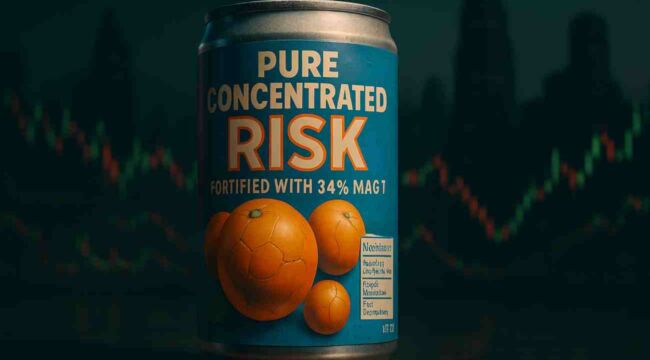Pure, Concentrated Risk
Over the past 10 years, a $10,000 investment in the S&P 500 would have grown to around $38,260. That’s based on the SPY ETF with dividends reinvested.
But the tech-heavy Nasdaq 100 would have turned every $10,000 into $58,866 over the same period. That’s based on the QQQ ETF and also assumes dividends are reinvested.
Historically speaking, these are abnormally high returns. Instead of the 8% per year long-term average, broad U.S. stock indexes have essentially doubled that (or more) over the past decade.
The question investors should be asking is: is this sustainable?
My answer: no.
Take a look at the chart below. It shows the S&P 500’s CAPE (cyclically adjusted price/earnings) ratio. This metric looks at 10 years of price-to-earnings, and adjusts for inflation.

It’s also known as the Shiller PE ratio. When it’s sky high (like today) that means stocks are overvalued and should have low returns going forward.
The Shiller PE ratio today is at 39. That’s quite close to the 2000 highs of around 44. And far above the 1929 peak of 34.
And according to Warren Buffett’s favorite valuation metric, stocks are even more expensive than 2000. More on that in last month’s Bubble Poponomics.
To me, this is yet another signal that we’re nearing a local peak in U.S. markets. However, the market often ends these bubbly periods with one last great “blow-off top”. Whether this recent move qualifies is subjective, but my guess is that we might see at least one more sharp move up before the party ends.
Concentrated Risk
These big gains in both the S&P and the Nasdaq have been driven by one sector: big tech. Specifically, the “Magnificent 7”: Apple, Amazon, Alphabet, Meta, Microsoft, NVIDIA, and Tesla.
Over the past 10 years, the Mag 7 has returned a ridiculous 39% per year on average.
Even among these high-flyers, NVIDIA stands out. It is now the largest company in the world with a market capitalization of $4.3 trillion.
NVIDIA currently makes up a whopping 7.7% of the S&P 500. So out of the 500 largest publicly-traded companies in America, a single stock makes up almost 8%.
In total, the Mag 7 makes up about 34% of America’s standard benchmark index.
The Nasdaq 100 is even more concentrated with big tech. NVIDIA makes up 9.42% of the Nasdaq 100. Microsoft accounts for 8.3%, and Apple 8.2%.
The concentration risk here is extraordinary. At this point the fate of U.S. stock indexes are completely tied to this AI bubble. If (when) it falters, the house of cards will collapse. Consumer spending will plummet, then the broad market will follow.
As tempting as it is to guess the exact moment when the bubble will pop, it’s ultimately futile. So besides a few tiny hedges, I am mostly avoiding shorting this market for now.
Hedging Our Bets with Ex-U.S. investments
Most of us who live in America have plenty of exposure to the U.S. economy. Through our jobs, investments, dollars, and homes.
So it makes sense, in this environment, to hedge our bets. This is where gold and silver come into play. Miners too, of course. Precious metals are global assets which act as excellent hedges. In previous periods where bubbles popped, like after the dotcom one, precious metals and hard assets soared as formerly “hot sectors” plummeted.
And our emerging market thesis is starting to pay off, with the iShares Brazil ETF (EWZ) now up around 20% since we first wrote up that story. Brazilian markets are cheap with big yields, and thus have a lot less far to fall if things go south.
Oil is another contrarian bet I like. The energy sector is dirt cheap, offers fat dividend yields for compounding, and should offer significant protection against inflationary forces. More on that here.
By now, you regular readers may be getting tired of me writing about how gold, silver, miners, oil, and emerging markets are excellent alternatives to the standard big U.S. indexes.
But this is a point I really want to hammer home. We are entering what is sure to be a chaotic time for stocks, fiat currencies, and generally speaking, the world.
Don’t let the new all-time index highs fool you. This is a precarious time. Look at gold and silver. They are sending a more urgent message. Something isn’t right, and savvy investors can feel it coming.
Hedging our bets in this environment isn’t just a clever idea, it’s a necessity.



Comments: